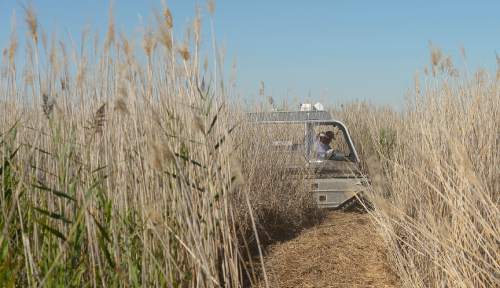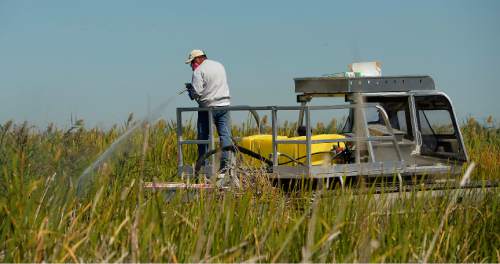This is an archived article that was published on sltrib.com in 2015, and information in the article may be outdated. It is provided only for personal research purposes and may not be reprinted.
Layton • The turn of weather this past weekend might have you thinking of scary swamp fiends with glowing eyes and oozing skin, but as the seasons change, conservationists in Utah turn their attention to a different kind of swamp monster.
This monster, an invasive reed-like plant called phragmites, looks innocent enough — like a tall, leafy cattail with a bushy top. But like the zebra mussel and kudzu and other infamously invasive imports, phragmites is known for its horror-movie ability to take over marshes and wetlands, crowding out native plants.
The growing invasion and the futility of previous fights against it — which did involve pitchforks and torches — have prompted The Nature Conservancy to purchase a $150,000 Marsh Master to mulch the monster weeds at the Great Salt Lake Shorelands Preserve.
At the shorelands preserve, Chris Brown, the preserve's director of stewardship, estimates phragmites has infiltrated about 20 percent of their 4,400 acres. He estimates that the plants have invaded as much as 80 percent of the neighboring shoreline that is owned and managed by the state — and that's just in the 35 years since phragmites first appeared in Utah.
Mike Kolendrianos, assistant manager of the Great Salt Lake Shorelines Preserve, said phragmites is believed to have colonized Utah during the floods of the 1980s. The floods caused the lake level to rise, which submerged and killed the shoreline's natural vegetation. That gave phragmites — which has light, fluffy seeds that travel easily on the wind, clothing, or fur or feathers — a foothold in the area.
Since then, the lake's natural variable water levels have helped the phragmites spread.
At first, Brown said, wildlands officials weren't sure exactly what kind of new plant they had on their hands. By the time they did figure it out, he said, it was too late.
"By the time everyone realized what we had," he said, "we were too far down the hole."
By now, phragmites has colonized more than the Great Salt Lake — the reeds have been discovered near Bear Lake and Utah Lake, and in urban environments as well, Brown said.
Phragmites may grow well in Utah's environment, but it is bad for local wildlife, which don't eat the plant, Brown said. As the invasive reeds crowd out the natural ones, it destroys habitat for native birds and animals.
Phragmites is also highly flammable, which presents a problem for air quality, because the plant produces a thick, black smoke and lots of ash when it burns.
Air quality concerns have curtailed the preserves' ability to burn patches of phragmites. In recent years, that has left The Nature Conservancy spraying the weeds with Roundup from planes or helicopters, Brown said.
The preserve has tried using tractors to distribute the herbicide, Brown said, but found that terrestrial vehicles have a tendency to get stuck in mud.
"We would get stuck all the time, and spent days trying to get unstuck," he said.
Enter the Marsh Master — part boat, part tank, and part giant lawnmower. The Marsh Master is not only much better at navigating wetlands than your traditional tractor, but also capable of mulching the sprayed phragmites after it dies.
That step is especially important, Brown said, because the reeds grow in tight, dense clusters that can reach 10 feet tall. Even after they have been sprayed, the dead vegetation is so thick it prevents anything from growing underneath. And because phragmites is particularly tough and woody — in its native Europe, the plant was used to build thatched roofing — it can take years, even decades for the reeds to fully decompose.
Using the Marsh Master to mulch phragmites will accelerate that decomposition process, Brown said, giving native foliage a better chance at re-establishing itself in cleared phragmites stands.
Marsh Masters are relatively common machines in southern states like Louisiana, where they are used to navigate wetlands and to maintain pipelines, oil wells and other projects, Brown said. But in Utah, the treaded boat — and, since all 6,000 pounds of it is capable of floating, it is officially considered a boat — is a little more unique.
It's not that the Marsh Master is any less useful in Utah, Brown said, but the cost is prohibitive. He said the Great Salt Lake Shorelands Preserve was able to make the purchase thanks to a generous donor.
But the Marsh Master isn't a silver bullet, said Brown, who doesn't believe Utah conservationists will ever completely rid the state of phragmites.
"I've been spraying phrag since 1996," he said, "and sometimes I feel like I'm going in a circle, but we have to try."
@EmaPen











